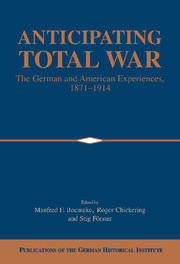Book contents
- Frontmatter
- Introduction
- Part One Germany, The United States, and Total War
- Part Two War and Society
- 3 The Political Economy of Warfare in America, 1865-1914
- 4 Hugo Stinnes and the Prospect of War Before 1914
- 5 War Preparations and Ethnic and Racial Relations in the United States
- 6 Religion and War in Imperial Germany
- 7 Socializing American Youth to Be Citizen-Soldiers
- 8 Preparing German Youth for War
- 9 Heroes and Would-Be Heroes: Veterans' and Reservists' Associations in Imperial Germany
- 10 Mobilizing Philanthropy in the Service of War: The Female Rituals of Care in the New Germany, 1871-1914
- Part Three Memory and Anticipation: War and Culture
- Part Four The Experience of War
- Index
7 - Socializing American Youth to Be Citizen-Soldiers
Published online by Cambridge University Press: 05 January 2013
- Frontmatter
- Introduction
- Part One Germany, The United States, and Total War
- Part Two War and Society
- 3 The Political Economy of Warfare in America, 1865-1914
- 4 Hugo Stinnes and the Prospect of War Before 1914
- 5 War Preparations and Ethnic and Racial Relations in the United States
- 6 Religion and War in Imperial Germany
- 7 Socializing American Youth to Be Citizen-Soldiers
- 8 Preparing German Youth for War
- 9 Heroes and Would-Be Heroes: Veterans' and Reservists' Associations in Imperial Germany
- 10 Mobilizing Philanthropy in the Service of War: The Female Rituals of Care in the New Germany, 1871-1914
- Part Three Memory and Anticipation: War and Culture
- Part Four The Experience of War
- Index
Summary
Despite “interesting” changes in battlefield technology, the U.S. War Department assured American draftees in 1917 that victory still depended “more on nerve and fighting spirit” than on “weapons and armor.” The “spirit” animating the new national army would combine “democratic feeling, . . . love for the Nation, and . . . Americanism.” The prospective “citizen- soldier” - a term repeated incessantly throughout the Home Reading Course for Citizen-Soldiers sent to every conscript - was to learn perfect respect for the American flag, practice saluting, and expect many hours of close-order drill to learn “precision, teamwork, and . . . prompt and unhesitating obedience.” He was to realize that “the soldier is not an individual player in the great game of war; he is valuable chiefly as a member of a team.” In the pamphlet's most insistent metaphor, squads, companies, regiments, and divisions all were teams. Indeed, the whole army, the draftee learned, “is handled just like a football team. . . . When the signal is given, all work together - all play the game - teamwork.” Yet just as in sports, the soldier also would need individual “spirit, tenacity, and self-reliance,” the last a virtue particularly “characteristic of the American.” Simple skills would suffice: “Many men . . . become expert in picking up enemy bombs before they explode and throwing them back.”
- Type
- Chapter
- Information
- Anticipating Total WarThe German and American Experiences, 1871–1914, pp. 137 - 166Publisher: Cambridge University PressPrint publication year: 1999



